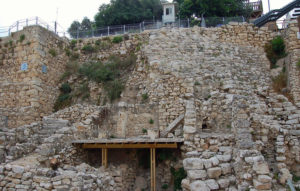
City of David’s Stepped Stone Structure (Photo by Don Knebel)
According to the Bible, David captured Jerusalem from the Jebusites in the ninth or tenth centuries B.C. and made it the capital of a kingdom uniting the twelve tribes of Israel. People today probably imagine Jerusalem at the time as a great city, befitting their view of David’s United Monarchy. But most scholars believe that David’s Jerusalem occupied a narrow hilltop strip no more than 300 feet wide and 1500 feet long, with a population of perhaps two thousand. This area, called the “City of David, was southeast of the hill called “Mount Moriah” where King Solomon later build the first Jewish Temple.
Excavations in the City of David area began in the nineteenth century. In the 1920s, archaeologists discovered a sixty-foot high terraced structure made of stone along the eastern side of the hill, overlooking the Kidron Valley. The purpose of this structure, labeled the “Stepped Stone Structure,” has long been a mystery. In 2005, Dr. Eliat Mazar, an Israeli archaeologist, reported that she had found another stone structure, just as unimaginatively called the “Large Stone Structure,” at the top of the Stepped Stone Structure. With great fanfare, she said had found David’s palace, founded by the Stepped Stone Structure. Other archaeologists quickly disagreed, saying that there would not be a palace in such a small “hill-country village.”
The site of Dr. Mazar’s excavations, labeled “Area G,” has become a popular tourist destination in Jerusalem. Guides point out that whatever the purpose of the Stepped Stone Structure, the purpose of the square stone at its lower right-hand corner, with a hole in the center, is clear.
Comments are closed.